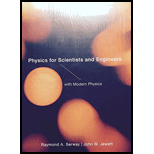
Concept explainers
(a)
The specific heat of unknown sample.
(a)
Answer to Problem 13P
The specific heat of unknown sample is
Explanation of Solution
Given info: The mass of the calorimeter is
Formula to calculate the heat lost by cooper block is,
Here,
Formula to calculate the heat lost by unknown sample is,
Here,
Formula to calculate the heat gained by the water is,
Here,
Formula to calculate the heat gained by calorimeter is,
Here,
From the conservation of energy, heat lost is equal to heat gained.
Substitute
Conclusion:
Therefore, the specific heat of unknown sample is
(b)
The specific heat of unknown sample.
(b)
Answer to Problem 13P
The unknown sample may be beryllium.
Explanation of Solution
Given info: The mass of the calorimeter is
The specific heat of unknown sample is
This value of specific heat is not given in the given table. So, it is difficult to make a definite identification of the sample. The closest value of this which is given in table is
Conclusion:
Therefore, the unknown sample may be beryllium.
(c)
To explain: The answer obtained in part (b).
(c)
Answer to Problem 13P
The specific heat may be defined as either the material having this amount of specific heat is not listed in the table or it may be an unknown alloy.
Explanation of Solution
The specific heat may be defined as the heat capacity per unit mass. It is the amount of heat per unit mass required to raise the temperature by
The value of specific heat obtained in part (b) does not correspond to any material given in table 19.1. So, either the material is not listed in the table or it may be an unknown alloy.
Conclusion:
Therefore, either the material having this amount of specific heat is not listed in the table or it may be an unknown alloy.
Want to see more full solutions like this?
Chapter 20 Solutions
Physics For Scientists And Engineers With Modern Physics, 9th Edition, The Ohio State University
- 3. If the force of gravity stopped acting on the planets in our solar system, what would happen? a) They would spiral slowly towards the sun. b) They would continue in straight lines tangent to their orbits. c) They would continue to orbit the sun. d) They would fly straight away from the sun. e) They would spiral slowly away from the sun. 4. 1 The free-body diagram of a wagon being pulled along a horizontal surface is best represented by A F N B C 0 Ꭰ FN E a) A b) B c) C app app The app 10 app d) e) ס ח D E 10 apparrow_forwardPls help ASAParrow_forwardPls help asaparrow_forward
- Pls help asaparrow_forwardThe acceleration of an object sliding along a frictionless ramp is inclined at an angle 0 is 9. a) g tano b) g cose c) g sino 10. d) g e) zero A 1.5 kg cart is pulled with a force of 7.3 N at an angle of 40° above the horizontal. If a kinetic friction force of 3.2 N acts against the motion, the cart's acceleration along the horizontal surface will be a) 5.0 m/s² b) 1.6 m/s² c) 2.4 m/s² 11. d) 1.0 m/s² e) 2.7 m/s² What is the net force acting on an object with a mass of 10 kg moving at a constant velocity of 10 m/s [North]? a) 100 N [North] b) 100 N [South] 10 N [North} d) 10 N [South] e) None of these.arrow_forwardModified True/False - indicate whether the sentence or statement is true or false. If the statement is false, correct the statement to make it true. 12. An object in uniform circular motion has a constant velocity while experiencing centripetal acceleration. 13. An object travelling in uniform circular motion experiences an outward centrifugal force that tends to pull the object out of the circular path. 14. An object with less inertia can resist changes in motion more than an object with more inertia. 15. For an object sliding on a horizontal surface with a horizontal applied force, the frictional force will always increase as the applied force increases.arrow_forward
- Pls help asaparrow_forwardAnswer the given question showing step by step by and all necessary working out.arrow_forward1. The piston in the figure has a mass of 0.5 kg. The infinitely long cylinder is pushed upward at a constant velocity. The diameters of the cylinder and piston are 10 cm and 9 cm, respectively, and there is oil between them with v = 10⁻⁴ m^2/s and γ = 8,000 N/m³. At what speed must the cylinder ascend for the piston to remain at rest?arrow_forward
 Physics for Scientists and Engineers: Foundations...PhysicsISBN:9781133939146Author:Katz, Debora M.Publisher:Cengage Learning
Physics for Scientists and Engineers: Foundations...PhysicsISBN:9781133939146Author:Katz, Debora M.Publisher:Cengage Learning Principles of Physics: A Calculus-Based TextPhysicsISBN:9781133104261Author:Raymond A. Serway, John W. JewettPublisher:Cengage Learning
Principles of Physics: A Calculus-Based TextPhysicsISBN:9781133104261Author:Raymond A. Serway, John W. JewettPublisher:Cengage Learning College PhysicsPhysicsISBN:9781285737027Author:Raymond A. Serway, Chris VuillePublisher:Cengage Learning
College PhysicsPhysicsISBN:9781285737027Author:Raymond A. Serway, Chris VuillePublisher:Cengage Learning Physics for Scientists and Engineers, Technology ...PhysicsISBN:9781305116399Author:Raymond A. Serway, John W. JewettPublisher:Cengage Learning
Physics for Scientists and Engineers, Technology ...PhysicsISBN:9781305116399Author:Raymond A. Serway, John W. JewettPublisher:Cengage Learning Physics for Scientists and EngineersPhysicsISBN:9781337553278Author:Raymond A. Serway, John W. JewettPublisher:Cengage Learning
Physics for Scientists and EngineersPhysicsISBN:9781337553278Author:Raymond A. Serway, John W. JewettPublisher:Cengage Learning Physics for Scientists and Engineers with Modern ...PhysicsISBN:9781337553292Author:Raymond A. Serway, John W. JewettPublisher:Cengage Learning
Physics for Scientists and Engineers with Modern ...PhysicsISBN:9781337553292Author:Raymond A. Serway, John W. JewettPublisher:Cengage Learning





